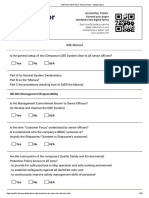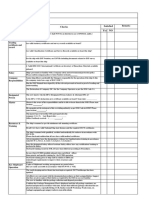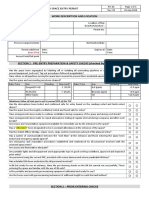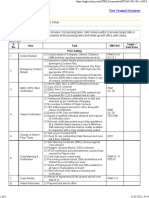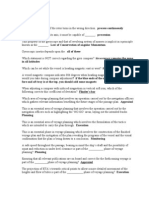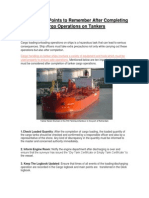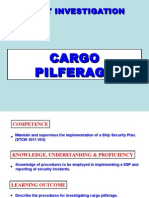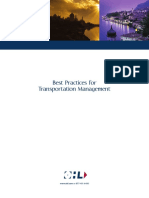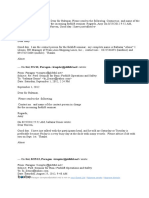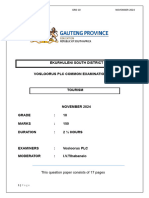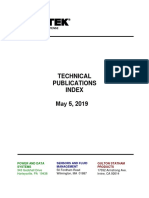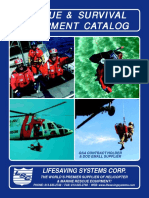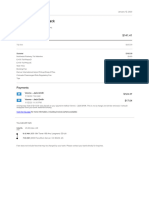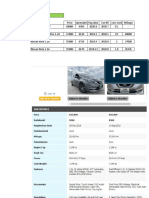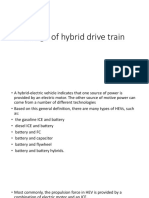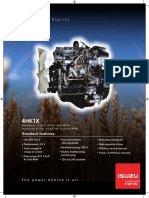Internal Audit Questions
Internal Audit Questions
Uploaded by
Abner LlenosCopyright:
Available Formats
Internal Audit Questions
Internal Audit Questions
Uploaded by
Abner LlenosCopyright
Available Formats
Share this document
Did you find this document useful?
Is this content inappropriate?
Copyright:
Available Formats
Internal Audit Questions
Internal Audit Questions
Uploaded by
Abner LlenosCopyright:
Available Formats
Certification Assistance for Marine Engineers
ISO ISM Audit Questions
Brought to you by www.dieselduck.net, comments to webmaster@dieselduck.net
On this page you will find many questions. These questions were part of
the ISM / ISO certification process that our company went through (2000), also known as
the safety audit.
You will notice that most questions do not pertain to the engineering staff of the ship,
further more, you will notice that allot of the questions don't even applied to shipboard
staff. But nonetheless, the crew on the ship I was on was nervous about the type of
questions they would face. And for your information, the auditor did spend about fifteen
minutes with the lowest rank in the engine room! So, to help relieve some stress and
help you get your mind on the right track, I present these questions for your perusal.
Please feel free to use the discussion forum or the contact form should you have comments
or any other questions about these questions.... any question?
On to it...
The number at the front of a question is suppose to be the reference to the ISM code.
1.1 How well understood is the object of the ISM Code?
5.0 Verify the addresses and contact numbers of the company’s head office and regional
office.
7.0 Determine that staff knows location of definitions in FSM (fleet safety manual).
7.0 Core understanding of definitions of "observation" and "non-conformity".
8.1 Check availability of publications in departmental libraries.
1.0 Is the commissioner’s safety policy posted prominently?
1.4 What is the posted version date?
1.0 Is staff familiar with the safety policy?
2.0 Is the drug and alcohol Policy posted prominently?
2.0 What is the posted version date?
2.3.2 Does staff know the rule on impairment?
2.3.5 Does staff know the five hour rule?
2.3.6 Does staff know their obligation in turning over a watch?
Does supervisory staff know the over-all organizational structure for the FSM?
Does staff know the ship specific organizational structure for the FSM?
Do supervisors have a reasonable understanding of the position responsibilities of the
Director of Operations?
Does staff have a reasonable understanding of the position responsibilities of the
Commanding Officer?
Does staff have a reasonable understanding of the position responsibilities of their
Department Head?
Does the Marine Superintendent have copies of job descriptions?
Are copies of job descriptions held aboard?
Has staff received a copy of their own job description?
Does the job description held by the staff member agree with the job description for the
position that is held ashore by the Marine Superintendent?
4.0 Who Is the NDPA? (Shore Managers and RDPA’s)
4.0 Who is the RDPA? (All personnel)
2.0 & 3.0 Evidence of ships being advised of temporary replacement of the DPA? Does
this tally with shore records of absence of the DPA?
4.0 Verify contact numbers of the RDPA
Verify DPA's are familiar with their responsibilities.
1.1 Verify Commanding Officer is aware of own responsibility.
1.2 Number of items reported to the DPA since the last audit. Compare against register
of non-conformances.
1.3.2 Evidence of systematic reviews of safety and pollution prevention activities.
1.3.4 Have activities been undertaken to motivate crew?
1.3.9 What is last date shown for review of on-board plans and procedures? Has review
been conducted regularly?
2.2 Evidence that Commanding Officer is conversant with the FSM.
2.4 Verify that orders and instructions are posted, dated, and signed.
2.5 Obtain records of on-board safety meetings and drills. Are they regular?
2.6 Has systematic review been conducted so that all procedures have been reviewed
within a two-year period?
2.6 Has crew been involved in the review of the system?
2.6 Records of RDPA being notified of reviews conducted?
2.6 RDPA records follow up or tracking to ensure reviews being completed.
3.1 Seek evidence that Commanding Officer fully understands and is prepared to
exercise authority as may be required by circumstances or conditions.
3.3.1 Sight copies of Commanding Officer’s Standing Orders.
3.4.1 Are Night Orders used regularly?
4.0 Review logbook entries for drills, exercises, and inspections.
4.0 Review minutes of Safety Management Meetings - check to ensure all items have
been actioned or corrective action plan is in place to deal with outstanding items.
4.0 Review file of non-conformance reports.
4.0 Review record of review of manual procedures. Are reviews conducted regularly?
4.0 Is Fleet Safety Manual up-to-date? Confirm manual number (or numbers if more
than one held) against DPA register.
1.1 Review personnel records of Commanding Officers for certificates, CPE, and
medical.
2.1.1 Seek evidence that methods employed to ensure officers are qualified for positions
held.
2.2.1 Seek evidence that methods employed to ensure crewmembers are qualified for
positions held.
2.3.1 Verify competency profiles have been established for each ship and that they are
posted.
4.1 Obtain records of training conducted.
5.2 What is the designated language of work aboard the ship?
5.3 By observation, are there individuals aboard who do not appear familiar with the use
of the language designated for use aboard the ship?
2.2 Are there signed competency profiles for all ships in the region on file?
2.2 Are the certification requirements in the competency profiles in accordance with the
company’s and the crewing regulations?
2.3 Seek evidence that the Marine Superintendent ensures that persons assigned to ships
have met the competency and certification standards?
2.3 Take representational sample of Marine Superintendent’s crewing records and
compare against competency profiles.
2.3 Does the Marine Superintendent conduct reference checks and does the Marine
Superintendent authenticate certification documents?
2.4 How many occasions since the previous audit has the marine superintendent
informed the Operations Center that the competency profile is not sufficient to meet
planned operations?
2.5 Review requests for Exemption, are they signed by the marine superintendent and
counter signed by the DPA?
2.6 Seek evidence that the Commanding Officer reviews certificates and records when
personnel sign-on.
2.7 Have the competency profiles been developed by the Commanding Officer in
consultation with the Director of Operations?
2.8 Are heads of departments continually monitoring and assessing subordinates? Sight
records.
3.1 Does the Marine Superintendent maintain a register of seafarer certificates?
3.1 Is there evidence that the Register is sighted quarterly?
3.1 Is there evidence of follow-up when certificates are expiring or have expired?
3.3 Are competency profiles established and posted for all positions under all operating
regimes aboard the vessel?
3.4 Is there at least one entry level position shown in the competency profiles for each
department?
3.5 Has minimum manning been established in line with the SAR competency profile
for the vessel?
3.6.1 Is there evidence that qualifications are compared against certification and
competency requirements before assigning the seafarer to the vessel?
3.6.2 Is there evidence that newly appointed seafarers are familiarized before assuming
duties aboard?
3.6.2 Is there evidence that newly appointed seafarers are supervised before assuming
unsupervised duties aboard?
3.7.2 Do filed copies of exemption requests provide evidence that the situation-giving
rise to the request was sudden and unforeseen?
3.7.4 Are exemption approvals given and signed by the appropriate authority?
3.7.4 Is there any evidence that the ship sailed in advance of an exemption authority
being received?
3.7.5 Is there any evidence that the ship has sailed with more than one exemption being
used in a department?
3.7.6 Where exemptions have been granted, did the exemptee have a certificate not more
than one level below the level of certificate required for the voyage?
3.7.6 In the case of Commanding Officer exemptions, where such exemptions have been
granted, did the exemptee hold a Master’s qualification not more than one level below
the certificate require?
3.7.7 What evidence exists to support the fact that the Marine Superintendent conducted
a search for a suitably certified and qualified individual before requesting an exemption?
3.7.8 How was the practical ability of the examples assessed?
3.7.9 Were exemptions granted only for the minimum period required?
3.7.9 Is there any evidence that an exemption was relinquished immediately upon the
availability of a qualified person?
3.7.10 Were exemption requests filled out completely?
3.7.11 Have exemption requests been properly reported through the system to the Safety
Management System Review?
3.8.1 Do all persons aboard possess appropriate medical certification?
3.8.2 Are special medical evaluations completed following Iong absences for Illness or
Injury?
3.8.3 Is there evidence of a scheduling system to ensure medical evaluations are
completed on a timely basis?
3.8.4 Are there records of any person being removed from ships as a result of an "unfit'
medical evaluation?
Annex A Sight posted competency profile for completeness, signatures, and dates.
2.1 Has the Commanding Officer given directions on the content and scope of the
familiarization materials?
3.1 Is time is allowed on board the ship for new personnel to become familiar with their
duties? Does this vary by position and are time limits appropriate?
3.2.1 Is there evidence that all first time joiners have received familiarization training?
3.2.2 Is there a process in place which ensures that previous service is checked to ensure
that all joining personnel with more than six months elapsed since lost service aboard
are re-familiarized?
3.3.1 Is there a familiarization checklist used and does ft meet the minimum
requirements of the FSM?
3.3.2 Do all new Personnel complete supervised on-the-job training during their first
week aboard?
3.3.3 Is there evidence that new personnel are not standing watches or performing duties
unsupervised?
3.3.5 Site familiarization-training records and compare against Ship's Book.
3.4.1 Have processes and procedures ashore that are essential to ensure the effectiveness
of the safety management system been Identified?
3.4.2 Site familiarization checklists used ashore.
3.4.3 site shore site familiarization training records.
3.1 Is there evidence that supernumerary personnel have been familiarized prior to
sailing?
3.3 Are there Copies of the declaration of Health for all supernumerary personnel that
have been carried aboard?
3.4 Have non-employees of the Department completed the passenger waiver and Release
Form?
3.5 Have Supernumerary personnel signed the Ship's Book on joining and departing?
3.6 Is there evidence that personnel who have refused to sign the Ship's Book or
complete the declaration of health having been refused carriage?
2.2 Has identified training been provided in a timely fashion?
2.3 Are individual training records maintained and are they complete?
2.4 Are training plans available?
3.1.1 Are training requirements identified and are they reviewed biennially?
3.1.2 Are annual training plans in place for each employee?
3.1.3 Are unique unit-specific training requirements identified and is there a training
plan in place for these elements?
3.2.1 Have shore managers satisfied training to IMO Course 6.03?
3.2.2 Have crewing officers satisfied training to IMO Course 5.04?
3.3.1.1 Have employees been provided with training necessary to the safe performance
of their positions?
3.3.1.2 Are there records of training having been completed satisfactorily before
employees are tasked with completing duties unsupervised?
3.4.1 Are training records maintained detailing employee’s work and training history?
2.1 Do the Commanding Officer’s Standing Orders contain specific Instructions related
to access to the bridge?
3.3 Are Office-of-the-Watch familiar with their authority to suspend visits to the bridge
where necessary?
3.5 Are restricted entry signs posted at entrances to the bridge?
2.2 Are the watchkeeping arrangements on the bridge adequate for the conditions and
operations?
3.1 Are the International Regulations for Preventing Collisions at Sea available on the
bridge and is there evidence that the OOW's observe the Regulations?
3.2 Are watches conducted-in accordance with the Watchkeeping Standards?
3.2 Has the Commanding Officer issued specific practices and procedures for the
conduct of a watch and are these instructions known and followed?
3.3 Are changes of watch logged?
3.3 Is the time when the commanding officer assumes control of navigation logged?
3.4 Have all watchkeepers attended a Bridge Resource Management Course?
3.5 Is the rest period called for in the watchkeeping Standards observed?
3.1 Are voyages pre planned?
3.2 Is the voyage plan communicated before the voyage commences?
3.2 Is there anecdotal evidence that suggestions for improvements to the voyage plan are
solicited or welcome?
3.3 Is it clear to all watchkeepers when the vessel is to be operated in pilotage mode?
3.4 Are modified plans used for operational phases?
3.5.1 Are appropriate folios or charts carried for the intended voyages?
3.5.2 Are charts corrections up-to-date with the latest Notice to Mariners?
4.0 Are voyage plans on file and do they appear to have been prepared completely?
3.1 Has the Commanding Officer issued clear instructions to be followed in case of
restricted visibility?
3.3 Does the ship use a checklist in restricted visibility and is the use of the checklist
logged?
3.1.1.1 Is the commanding officer informed when the ship enters confined waters?
3.1.1.1 Is the engine room informed when the ship enters confined waters?
3.3.1.1 Is there evidence that the ship employs closer attention to the position of the ship
when in confined waters?
3.3.1.3 Is there evidence that more than one method of fixing is used?
2.1 Has the commanding officer issued any amplifying orders regarding the use of
lookout are these orders understood and followed?
2.3 Do lookouts report for duty in advance of the required time to allow-for adjustments
to conditions?
3.1 Are lookouts employed as required by the Canadian Watchkeeping Standards?
3.2.1 Does the OOW ensure that each lookout is fit for duty?
3.2.2 Are the names and times of the watch logged for each lookout?
3.2.3.1 Is there anecdotal evidence that lookouts are employed solely for that purpose?
3.2.3.2 Does the OOW brief the lookout on the duties of the position?
3.2.3.3 Are the means of communication between the OOW and lookout known and
tested?
3.2.3.4 Does the OOW ensure that lookouts are relieved regularly to ensure fitness and
efficiency?
3.3.1 Is there anecdotal evidence that lookouts understand the duties of their position?
3.3.3 Do Lookouts report when they are relieved and by whom?
3.1 Are deck officers familiar with the contents of Ice Navigation in Canadian Waters?
3.2 Is there evidence that closer attention is paid to navigation of the ship when in ice
covered waters and that navigation instruments are tested and checked?
3.3 Has the ship prepared checklists for conducting operations in ice covered waters?
3.1.1 Does the ship use an anchoring plan when coming to an anchorage?
3.1.1 Is this plan communicated to the Bridge Team?
3.1.2.2 Has the Engineroom been notified of intentions and requirements for auxiliary
machinery?
3.1.2.3 Has maneuvering machinery been tested and logged?
3.1.4 Does the ship observe the practice of walking out the chain in deep anchorage?
3.2.1 Are confined spare entry Procedures in Place for entering the chain locker?
3.2.2 Do personnel entering the chain locker wear the appropriate protective equipment?
3.2.5 When removing personnel from the chain locker is anchor hoisting stopped?
2.3 If required, does the ship have checklists for transiting canals?
2.3 If the ship does not carry a checklist, and if a canal has been transited since the
previous audit, is there a plan on file?
3.1 Are canals Regulations and Sailing Directions carried as may be appropriate?
3.2.1 Are primary and secondary communication established with line handling location
before transit?
3.2.4 Is the Engineroom informed to verify standby and required equipment is tested and
ready?
3.2.5 Are winches tested prior to transit and is this it logged?
2.2 Does the crew understand who is the commanding officer’s delegate for the
supervision of cargo operations?
3.1 Are the requirements of the tackle Regulations observed in cargo handling?
3.2 Is the cargo handling crew wearing the appropriate personal protective equipment?
3.3.1 Can it be confirmed that the commanding officer’s delegate inspects slings, hooks,
shackles, and other devices prior to operation?
3.3.2 Do the crane operators and the signalmen both understand and use appropriate
hand signals?
3.3.3 Does the commanding officer’s delegate inspect cargo to be loaded?
3.3.4 Are the cargo plans used when necessary?
3.3.5 Are cargo plans used when requires by the Transportation of Dangerous Goods
Regulations?
3.4.1 Is the lift area free from debris and are tag lines adequately manned?
3.4.2 Is the access to the working area controlled?
3.4.3 Are cargo weights known so that SWL’s are observed?
4.0 Are SWL’s clearly marked on all lifting machinery and appliances?
1.1.1 Martin’s Marine Engineering Page rocks! http://members.home.net/diesel-duck
3.1 Are the fall protection standards of the Marine Occupational Safety and Health
Regulations readily available?
3.1 Are fall protection systems inspected prior to use?
3.2 Is there evidence that Personnel routinely report deficiencies found with fall
protection equipment?
3.3 Do fall-protection systems used aboard meet the minimum standards?
3.4 Is fall-protection systems quarantine after fall arrest until inspected and passed by a
qualified person?
3.5 Are lockout systems used systematically and appropriately and is the use of lockouts
logged?
3.6 Have appropriate checklists been created for work aloft or work over the side?
3.7 Are equipment records maintained In accordance with the procedure?
3.1.1 Has the Chief Engineer issued written instructions to subordinates for routine
engineering tasks aboard the vessel?
3.1.1 Are the Chief Engineer’s Standing Orders signed and dated?
3.1.1 Is there evidence that engineers have seen the Chief Engineer’s Standing Orders?
3.2.1 Are engineering watches conducted in accordance with the Canadian
Watchkeeping Standard and the Chief Engineer’s Standing Orders?
3.2.2 Are watch changes recorded in the Chief Engineer’s logbook?
3.3.1.1 Are pre-watch inspections made?
3.3.1.4 Is there evidence that a system is in place to ensure that the relieving engineer is
made aware of ongoing work being performed in the engine room?
3.3.1.7 Is there evidence that the engineer OOW determines that engine room personnel
are capable of performing their duties?
3.4.1 Is a copy of the Canadian watchkeeping Standard accessible to Engine room
personnel?
3.4.2 Have ship-specific instructions been written in sufficient quantity and detail to
adequately cover the systems listed in this procedure?
3.5.1.1 Are pre hand-over rounds completed by the departing engineer?
3.5.1.2 Does the departing engineer record machinery that has been isolated, bypassed,
or undergoing maintenance?
3.5.1.3 Are log book entries completed and signed before the departing engineer is
relieved?
3.5.1.4 Is there evidence that the departing engineer OOW determines that the relieving
engineer is capable of carrying out his or her duties?
3.5.1.5 Is there evidence that abnormalities or deficiencies are discussed and/or rectified
before the watch is handed over?
2.1 Is there evidence that the Commanding Officer knows if ballast water discharge
restrictions are applicable to the ship’s zone of operations and that these regulations are
observed?
2.2 Has the Marine Superintendent compiled a list of ballast water discharge restrictions
that apply to the geographic zone of operations?
3.1 Are the voluntary Guidelines applied when transiting fresh water?
3.3 Are ballast operations planned to account for hull stresses, stability, sea conditions,
and possible crossovers from the fuel system?
3.4 Are ballast operations logged?
3.5 Has the ship been issued with directions issued by local authorities respecting ballast
water discharge?
4.0 Site the Oily Water Separator Records.
2.1 Is there evidence that ship’s personnel are familiar with the Ship Oil Pollution
Emergency Plan (SOPEP)?
2.3 Are work scheduled established for bunkering operations?
2.4 Is there evidence that the Chief Officer is aware of local harbor regulations
pertaining to bunkering operations?
3.1 Has the ship developed specific checklists for transfer of oil and bunkering
operations?
3.1 Have the checklists addressed legislative requirements for bunkering and
transferring?
3.2.1 Is the SOPEP available on the Bridge?
3.2.7 Does the ship have Insulating flanges or non-conductive hoses?
3.2.12 Is there evidence that the ship routinely pipes announcements related to fueling
operations?
3.2.13 Is there evidence that NO SMOKING signs are posted when fueling?
3.3.1. Are fuel samples taken at least once per fueling?
3.3.4 Is there evidence that tanks have been loaded in excess of 95% of capacity?
3.5.2 Are blank flanges used on hoses as soon as they are disconnected?
3.5.4 Are final soundings of all fuel tanks taken upon completion of bunkering or
transferring operations?
3.5.6 Are entries In the Chief Engineer’s logbook complete and correct?
5.7 Have entries been made in the Deck logbook stating the times of bunkering
operations?
3.6.1 Has waste oil been disposed of through a contractor licensed or registered with
provincial authorities?
Do entries in the Oil Record Book, the Chief Engineer’s Log, and the Deck Log
materially agree?
Digitized by Martin for Martin's Marine Engineering Page http://www.dieselduck.net, June 2000
You might also like
- Mercruiser 4.3-5.0 MPI Engine ManualDocument140 pagesMercruiser 4.3-5.0 MPI Engine Manualkenrackliff75% (4)
- Typical Emergency Action PlanDocument9 pagesTypical Emergency Action PlanDiwakar Singh100% (1)
- SIRE 2.0 To VIQ7 - Comparative Analysis - Version 1.0 (January 2022)Document109 pagesSIRE 2.0 To VIQ7 - Comparative Analysis - Version 1.0 (January 2022)moashi chandra100% (1)
- Tug Master - Performance AssessmentDocument6 pagesTug Master - Performance AssessmentSafix YazidNo ratings yet
- ISM - ISO - ISPS - MLC Internal Audit - SafetyCultureDocument28 pagesISM - ISO - ISPS - MLC Internal Audit - SafetyCultureAbner Llenos100% (5)
- ISM and ISPS ChecklistDocument18 pagesISM and ISPS ChecklistAquiles Saburo100% (12)
- STCWDocument37 pagesSTCWJohn Mithu80% (5)
- Mod 5 Unit 30 International Safety Management CodeDocument12 pagesMod 5 Unit 30 International Safety Management CodeMc LiviuNo ratings yet
- Onboard SafetyDocument2 pagesOnboard SafetyEduard GabrielNo ratings yet
- Form of International Sewage Pollution Prevention Certificate-Annex-4-Of-MARPOL-updatedDocument4 pagesForm of International Sewage Pollution Prevention Certificate-Annex-4-Of-MARPOL-updatedMariner's CircleNo ratings yet
- Isps Code Presentation by SPC PDFDocument10 pagesIsps Code Presentation by SPC PDFIkoy Setyawan Keren100% (1)
- Bridge10 - Port Watch ChangeoverDocument1 pageBridge10 - Port Watch ChangeoverDrago DragicNo ratings yet
- Group-Delta-Nav-7-Reporting (Mt33-A1) Nav 7 333L3Document17 pagesGroup-Delta-Nav-7-Reporting (Mt33-A1) Nav 7 333L3Christian Felix Guevarra100% (1)
- Directorate General of Shipping, Govt. of India: Assessment Check ListDocument2 pagesDirectorate General of Shipping, Govt. of India: Assessment Check ListChetanNo ratings yet
- Executive Summary:: International Maritime OrganizationDocument24 pagesExecutive Summary:: International Maritime OrganizationAttar AkbarNo ratings yet
- Introduction To Isps Code: Bureau Veritas - Marine Division - Training SolutionsDocument1 pageIntroduction To Isps Code: Bureau Veritas - Marine Division - Training SolutionsRonald AranhaNo ratings yet
- International Safety Management CodeDocument18 pagesInternational Safety Management Codepolaris25No ratings yet
- Ism Audit Preparation - Dec 20Document5 pagesIsm Audit Preparation - Dec 20Mohana Rangesh100% (2)
- PSC14EDocument62 pagesPSC14ENguyen Huu TriNo ratings yet
- MEO Class 1 Written Examinations Model QuestionsDocument4 pagesMEO Class 1 Written Examinations Model QuestionsPraveen AbisakeNo ratings yet
- Training Manual For Fire Safety PracticeDocument50 pagesTraining Manual For Fire Safety PracticeMatthew BennettNo ratings yet
- Ms-I-81 Anchoring and Anchor Watch ChecklistDocument3 pagesMs-I-81 Anchoring and Anchor Watch ChecklistYusuf AnginNo ratings yet
- Stowaways 2020Document36 pagesStowaways 2020MEHDINo ratings yet
- Chapter 1. General InformationDocument33 pagesChapter 1. General InformationaliNo ratings yet
- Per 01 - Enclosed Space Entry PermitDocument3 pagesPer 01 - Enclosed Space Entry PermitRajesh Nair100% (1)
- History of MarpolDocument41 pagesHistory of MarpolstabinmathewNo ratings yet
- Man OverboardDocument2 pagesMan OverboardIlija BaldicNo ratings yet
- PSC Form BDocument1 pagePSC Form BBHASKAR HALDARNo ratings yet
- Sa004 Fixed Co2 Fire Fighting Systems PDFDocument1 pageSa004 Fixed Co2 Fire Fighting Systems PDFHocine TouatiNo ratings yet
- Garbage Record Book EntriesDocument2 pagesGarbage Record Book EntriesParminder singh parmarNo ratings yet
- Biofouling Record Book FormDocument10 pagesBiofouling Record Book Formlanato4901No ratings yet
- Skip To ContentDocument71 pagesSkip To ContentRushabh PatelNo ratings yet
- Preparation and Maintenance of Ships Deck LogDocument25 pagesPreparation and Maintenance of Ships Deck Logapi-265305076No ratings yet
- Existing Vessel Take Over ChecklistDocument6 pagesExisting Vessel Take Over ChecklistTamaro Raja Pahala MahaNo ratings yet
- Ism Code: Mohd. Hanif Dewan, Chief Engineer and Maritime Lecturer & Trainer, BangladeshDocument34 pagesIsm Code: Mohd. Hanif Dewan, Chief Engineer and Maritime Lecturer & Trainer, BangladeshDenada Anggia Dwi Putri100% (1)
- SMS Setup 3.2Document4 pagesSMS Setup 3.2कप्तान शैलेंद्रNo ratings yet
- Engine RatingsDocument2 pagesEngine Ratingsclinthen0% (1)
- ECM GD-09 - Preparation For USCG COC Exam - Rev 1-2015Document5 pagesECM GD-09 - Preparation For USCG COC Exam - Rev 1-2015guoterryNo ratings yet
- D.G Ov .Au: 5.0 Emergency ResponseDocument7 pagesD.G Ov .Au: 5.0 Emergency ResponseNgaire TaylorNo ratings yet
- Nickel Ore BritanniaDocument10 pagesNickel Ore BritanniagusoyongNo ratings yet
- Notices of ReadinessDocument20 pagesNotices of ReadinessWhoAm1No ratings yet
- Engine Room Pre-Arrival ChecklistDocument1 pageEngine Room Pre-Arrival Checklistrohithunni.pNo ratings yet
- Musters and Drills and On-Board Training & Instruction: Manx Shipping NoticeDocument7 pagesMusters and Drills and On-Board Training & Instruction: Manx Shipping NoticeAnkit Khokhar50% (2)
- Deck Operational Level: Theoretical Examination Practical AssessmentDocument1 pageDeck Operational Level: Theoretical Examination Practical AssessmentHarold SerranoNo ratings yet
- Ship Shore InterfaceDocument1 pageShip Shore InterfaceJMontesdeOcaCNo ratings yet
- Ballast Water Management: S M Tomiz Uddin:1055 Mfa 25, A1MC20180601-A (24) ALAM015268Document9 pagesBallast Water Management: S M Tomiz Uddin:1055 Mfa 25, A1MC20180601-A (24) ALAM015268Taufiq JahanNo ratings yet
- International Ballast Water Management Cert ProvisionalDocument1 pageInternational Ballast Water Management Cert ProvisionalLegal EnvitecNo ratings yet
- Guidance For Ship InspectionsDocument26 pagesGuidance For Ship InspectionsFr BNo ratings yet
- Section 9 Note of ProtestDocument2 pagesSection 9 Note of ProtestÞorsteinn Svanur Jónsson100% (1)
- Ism Code ImplementationDocument126 pagesIsm Code Implementationsanto deonNo ratings yet
- Guide To ISM-CodeDocument9 pagesGuide To ISM-Codenauta007No ratings yet
- Required Pilot Boarding Arrangements For Cargo ShipsDocument3 pagesRequired Pilot Boarding Arrangements For Cargo Shipsandrew1970gNo ratings yet
- Onboard Training Record Book For RatingsDocument7 pagesOnboard Training Record Book For RatingsTinsNo ratings yet
- Mar Env:: Protection of The Marine EnvironmentDocument9 pagesMar Env:: Protection of The Marine EnvironmentHaeisy SimsuangcoNo ratings yet
- F1 CM (1) Reviewer Chief Officer Materials.Document58 pagesF1 CM (1) Reviewer Chief Officer Materials.Alden Almaquer DelizoNo ratings yet
- 10 Important Points To Remember After Completing Cargo Operations On TankersDocument4 pages10 Important Points To Remember After Completing Cargo Operations On Tankersindumarnicaragua100% (3)
- TVL MARITIME Navigational Watch 3 May 2016Document7 pagesTVL MARITIME Navigational Watch 3 May 2016JohnRenzoMolinar100% (1)
- EEBD Solas+GuidelinesDocument6 pagesEEBD Solas+GuidelinesIrdam Jono100% (1)
- How To Fill Up Log BookDocument17 pagesHow To Fill Up Log BookАлексей Преподобный 1406No ratings yet
- Drug and Alcohol Declaration HOLIK LITODocument6 pagesDrug and Alcohol Declaration HOLIK LITOmusa ronaldNo ratings yet
- STPPDSPPS - Part D - Instructor's GuideDocument12 pagesSTPPDSPPS - Part D - Instructor's GuideR&DExactIloilo100% (1)
- CP4-Form02-CompanyQSE InternalAuditChecklistDocument12 pagesCP4-Form02-CompanyQSE InternalAuditChecklistianloubert20No ratings yet
- Sire 2.0 Accountability MatrixDocument4,450 pagesSire 2.0 Accountability MatrixNeeraj KumarNo ratings yet
- Marine Diesel OilDocument2 pagesMarine Diesel OilAbner LlenosNo ratings yet
- Internal SMS Audit Preparation Form: Annex ADocument56 pagesInternal SMS Audit Preparation Form: Annex AAbner LlenosNo ratings yet
- Marina Aud Itor'S Manual: Maritime Industry AuthorityDocument38 pagesMarina Aud Itor'S Manual: Maritime Industry AuthorityAbner LlenosNo ratings yet
- 6.09..ppt..cargo PilferageDocument7 pages6.09..ppt..cargo PilferageAbner LlenosNo ratings yet
- Best Practices For Transportation Management PDFDocument8 pagesBest Practices For Transportation Management PDFAbner LlenosNo ratings yet
- Your Guest List Approve Sender Approve DomainDocument1 pageYour Guest List Approve Sender Approve DomainAbner LlenosNo ratings yet
- 6.09..ppt..cargo PilferageDocument7 pages6.09..ppt..cargo PilferageAbner LlenosNo ratings yet
- Tourism Final Grade 10 2024Document17 pagesTourism Final Grade 10 2024lyndaledemonsNo ratings yet
- Science & Technology: Read The Passage Below and Answer The Questions That FollowDocument6 pagesScience & Technology: Read The Passage Below and Answer The Questions That FollowjoellenanamiNo ratings yet
- Type of Equipment Brand Model Capacity Serial No. Latest Location Cert. RenewalDocument2 pagesType of Equipment Brand Model Capacity Serial No. Latest Location Cert. RenewalFrancis SalongaNo ratings yet
- A Project Report On Customer Satisfaction in Tvs MotorsDocument86 pagesA Project Report On Customer Satisfaction in Tvs MotorsMunna MunnaNo ratings yet
- Ametek Technical - PublicationDocument105 pagesAmetek Technical - PublicationWallyNo ratings yet
- LSC 2008 Catalog PDFDocument36 pagesLSC 2008 Catalog PDFmoNo ratings yet
- Advanced Unit Test 3: GrammarDocument2 pagesAdvanced Unit Test 3: GrammarAlinaNo ratings yet
- Uber Invoice TemplateDocument1 pageUber Invoice Templatec2pjpgjj26No ratings yet
- Bearmach Catalogue 19th EditionDocument428 pagesBearmach Catalogue 19th Editionpatpat83No ratings yet
- Unlock 3 - Reading - Progress Test 1Document4 pagesUnlock 3 - Reading - Progress Test 1Nhung Hà HồngNo ratings yet
- CarDocument19 pagesCarding liuNo ratings yet
- Ticket - AbibusDocument2 pagesTicket - Abibusganesh.pabbisettyNo ratings yet
- DNV Os C101Document148 pagesDNV Os C101AbhijitNo ratings yet
- Jindal Power Limited: 6X135MW ACPPDocument2 pagesJindal Power Limited: 6X135MW ACPPSadanand DubeyNo ratings yet
- Sample CDR For Mechanical Engineer PDF 3Document20 pagesSample CDR For Mechanical Engineer PDF 3gkin lorenzNo ratings yet
- Travel and GDS BasicsDocument14 pagesTravel and GDS BasicsinnersourceNo ratings yet
- 010521-Q2009248-R2 - Hicom Diecastings - MP 206-1650Document5 pages010521-Q2009248-R2 - Hicom Diecastings - MP 206-1650azria17No ratings yet
- User Brand Preference of Two BikesDocument106 pagesUser Brand Preference of Two BikesShahzad SaifNo ratings yet
- Unit 2 - Part1 - Design of Hybrid Drive TrainDocument27 pagesUnit 2 - Part1 - Design of Hybrid Drive TrainChandru ChandruNo ratings yet
- Kerbstones Installation GuidelinesDocument4 pagesKerbstones Installation Guidelinespartha_svnitNo ratings yet
- Multiple ChoiceDocument9 pagesMultiple ChoiceFatto SeiNo ratings yet
- Isuzu 4HK1X Sheet HRDocument4 pagesIsuzu 4HK1X Sheet HRfalahNo ratings yet
- Bus Routes 2023-24 NRCM - NewDocument7 pagesBus Routes 2023-24 NRCM - NewramadasNo ratings yet
- MMEL PL-34 Rev 5 DraftDocument4 pagesMMEL PL-34 Rev 5 DraftJoão Paulo LapaNo ratings yet
- Acc CementDocument30 pagesAcc CementSoumava MitraNo ratings yet
- 01 CPE Entry TestDocument8 pages01 CPE Entry TestMilaNo ratings yet
- Approved Driving Instructors Programme Stage 2 Car Driving Skills (PDFDrive)Document235 pagesApproved Driving Instructors Programme Stage 2 Car Driving Skills (PDFDrive)Roohi Joura RJNo ratings yet
- 09 - Assembled ValvesDocument2 pages09 - Assembled ValvesDesign V-Tork ControlsNo ratings yet
- U. 1Document25 pagesU. 1Md JrNo ratings yet




